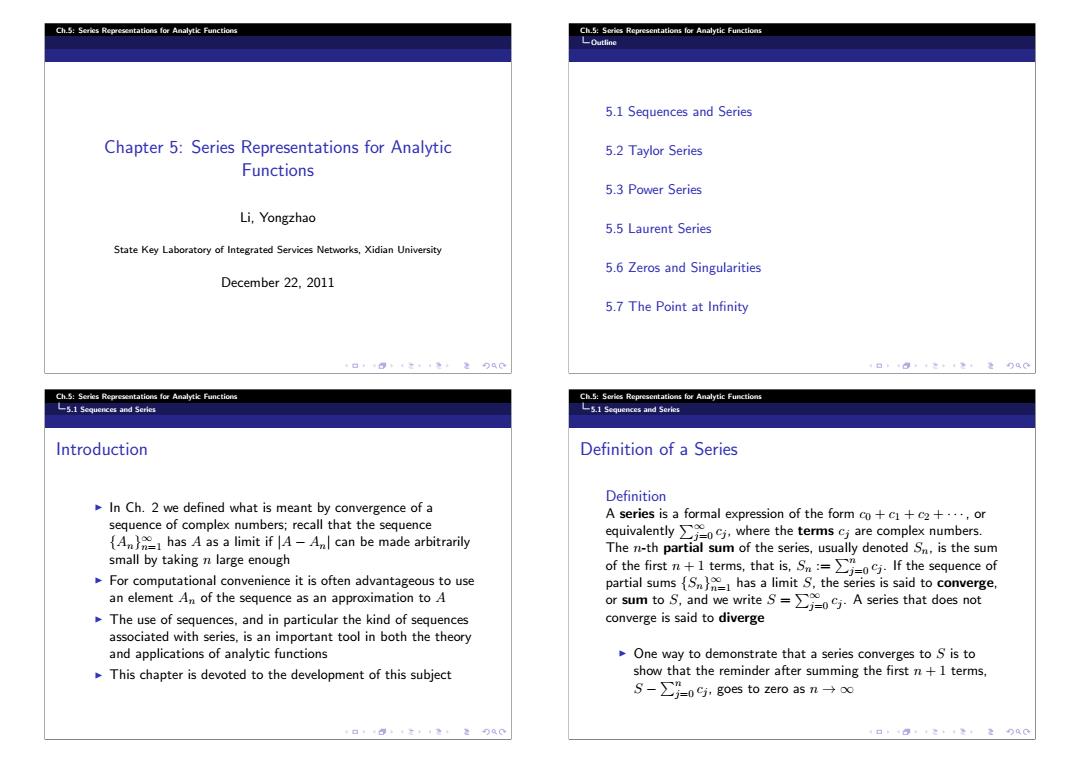
Ch.5:Series Representations for Analytic Functions Ch.5:Sories Representations for Analytic Functions 5.1 Sequences and Series Chapter 5:Series Representations for Analytic 5.2 Taylor Series Functions 5.3 Power Series Li,Yongzhao 5.5 Laurent Series State Key Laboratory of Integrated Services Networks,Xidian University 5.6 Zeros and Singularities December 22,2011 5.7 The Point at Infinity Ch.5:Series Representations for Analytk Functions Ch.5:Scrics Representations for Analytic Functions L5.1 Sequences and Series 5.1 Sequences and Series Introduction Definition of a Series Definition In Ch.2 we defined what is meant by convergence of a A series is a formal expression of the form co+c1+c2+...or sequence of complex numbers;recall that the sequence (An has A as a limit if |A-Anl can be made arbitrarily equivalently j.where the termscjare complex numbers. The n-th partial sum of the series,usually denoted Sn.is the sum small by taking n large enough of the firstn+terms,that is,If the sequence of For computational convenience it is often advantageous to use partial sums has a limit S,the series is said to converge. an element An of the sequence as an approximation to A or sum toand we writeAseries that does not The use of sequences,and in particular the kind of sequences converge is said to diverge associated with series,is an important tool in both the theory and applications of analytic functions One way to demonstrate that a series converges to s is to This chapter is devoted to the development of this subject show that the reminder after summing the first n+1 terms, S-∑y-09,goes to zero as n→∞
Ch.5: Series Representations for Analytic Functions Chapter 5: Series Representations for Analytic Functions Li, Yongzhao State Key Laboratory of Integrated Services Networks, Xidian University December 22, 2011 Ch.5: Series Representations for Analytic Functions Outline 5.1 Sequences and Series 5.2 Taylor Series 5.3 Power Series 5.5 Laurent Series 5.6 Zeros and Singularities 5.7 The Point at Infinity Ch.5: Series Representations for Analytic Functions 5.1 Sequences and Series Introduction In Ch. 2 we defined what is meant by convergence of a sequence of complex numbers; recall that the sequence {An}∞n=1 has A as a limit if |A − An| can be made arbitrarily small by taking n large enough For computational convenience it is often advantageous to use an element An of the sequence as an approximation to A The use of sequences, and in particular the kind of sequences associated with series, is an important tool in both the theory and applications of analytic functions This chapter is devoted to the development of this subject Ch.5: Series Representations for Analytic Functions 5.1 Sequences and Series Definition of a Series Definition A series is a formal expression of the form c0 + c1 + c2 + ··· , or equivalently ∞j=0 cj , where the terms cj are complex numbers. The n-th partial sum of the series, usually denoted Sn, is the sum of the first n + 1 terms, that is, Sn := nj=0 cj . If the sequence of partial sums {Sn}∞n=1 has a limit S, the series is said to converge, or sum to S, and we write S = ∞j=0 cj . A series that does not converge is said to diverge One way to demonstrate that a series converges to S is to show that the reminder after summing the first n + 1 terms, S − nj=0 cj , goes to zero as n → ∞���������
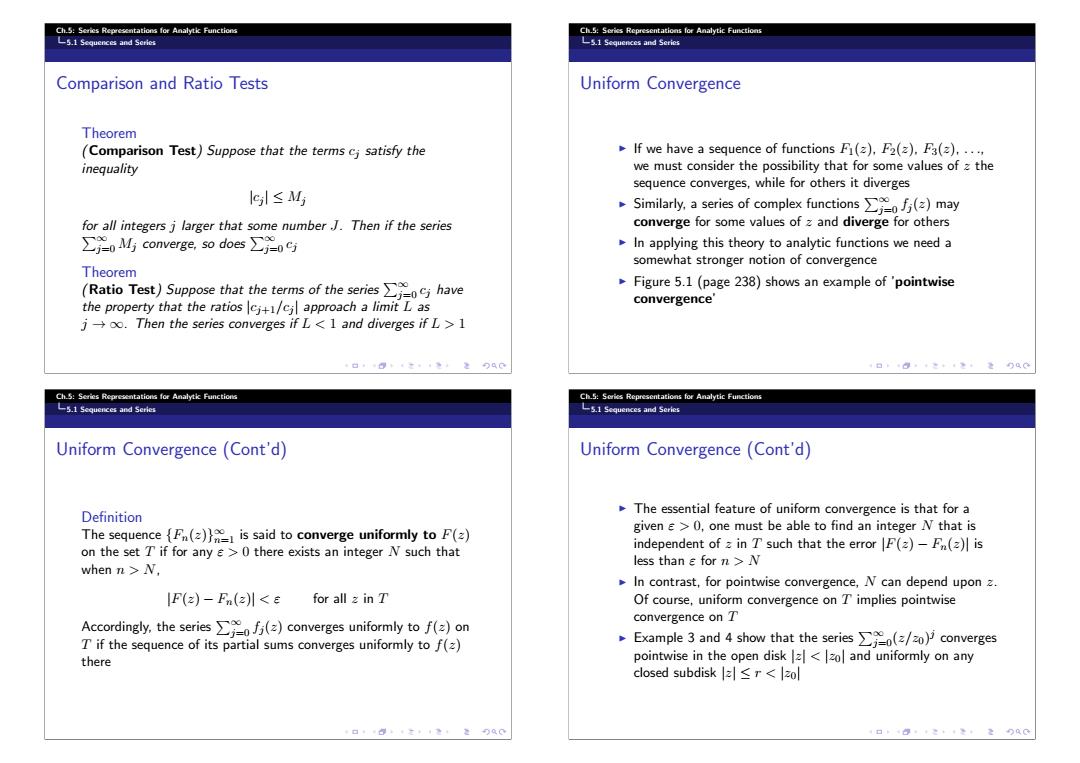
Ch.5:Series Representations for Analyti Functions Ch.5:Series Representations for Analytic Functions 5.1 Sequences and Series L5.1 Sequences and Serics Comparison and Ratio Tests Uniform Convergence Theorem (Comparison Test)Suppose that the terms cj satisfy the If we have a sequence of functions Fi(z),F2(z).F3(z)...., inequality we must consider the possibility that for some values of z the sequence converges,while for others it diverges lS≤M Similarly,a series of complex functions()may for all integers j larger that some number J.Then if the series converge for some values of z and diverge for others ∑24 converge,so does∑=oS In applying this theory to analytic functions we need a somewhat stronger notion of convergence Theorem (Ratio Test)Suppose that the terms of the series have Figure 5.1 (page 238)shows an example of 'pointwise the property that the ratios cj+/cjl approach a limit L as convergence joo.Then the series converges if L<1 and diverges if L>1 Ch.5:Series Representations for Analyti Functions Ch.5:Scrics Representations for Analytic Functions L5.1 Sequences and Series 5.1 Sequences and Series Uniform Convergence(Cont'd) Uniform Convergence(Cont'd) Definition The essential feature of uniform convergence is that for a The sequence {Fn(z)is said to converge uniformly to F(z) given >0,one must be able to find an integer N that is on the set T if for any >0 there exists an integer N such that independent of z in T such that the error F(z)-Fn(z)is when n>N, less than e for n>N In contrast,for pointwise convergence,N can depend upon z. IF(2)-Fn(2)<E for all z in T Of course,uniform convergence on T implies pointwise Accordingly,the series()converges uniformly to f(z)on convergence on T T if the sequence of its partial sums converges uniformly to f(z) Example 3 and 4 show that the series (/z)converges there pointwise in the open disk z<zol and uniformly on any closed subdisk <r<zol
Ch.5: Series Representations for Analytic Functions 5.1 Sequences and Series Comparison and Ratio Tests Theorem (Comparison Test) Suppose that the terms cj satisfy the inequality |cj | ≤ Mj for all integers j larger that some number J. Then if the series ∞ j=0 Mj converge, so does ∞j=0 cj Theorem (Ratio Test) Suppose that the terms of the series ∞j=0 cj have the property that the ratios |cj+1/cj | approach a limit L as j → ∞. Then the series converges if L < 1 and diverges if L > 1 Ch.5: Series Representations for Analytic Functions 5.1 Sequences and Series Uniform Convergence If we have a sequence of functions F1(z), F2(z), F3(z), ..., we must consider the possibility that for some values of z the sequence converges, while for others it diverges Similarly, a series of complex functions ∞j=0 fj (z) may converge for some values of z and diverge for others In applying this theory to analytic functions we need a somewhat stronger notion of convergence Figure 5.1 (page 238) shows an example of ’pointwise convergence ’ Ch.5: Series Representations for Analytic Functions 5.1 Sequences and Series Uniform Convergence (Cont’d) Definition The sequence {Fn(z)}∞n=1 is said to converge uniformly to F(z) on the set T if for any ε > 0 there exists an integer N such that when n>N, |F(z) − Fn(z)| < ε for all z in T Accordingly, the series ∞j=0 fj (z) converges uniformly to f(z) on T if the sequence of its partial sums converges uniformly to f(z) there Ch.5: Series Representations for Analytic Functions 5.1 Sequences and Series Uniform Convergence (Cont’d) The essential feature of uniform convergence is that for a given ε > 0, one must be able to find an integer N that is independent of z in T such that the error |F(z) − Fn(z)| is less than ε for n>N In contrast, for pointwise convergence, N can depend upon z. Of course, uniform convergence on T implies pointwise convergence on T Example 3 and 4 show that the series ∞j=0(z/z0)j converges pointwise in the open disk |z| < |z0| and uniformly on any closed subdisk |z| ≤ r < |z0|�������������
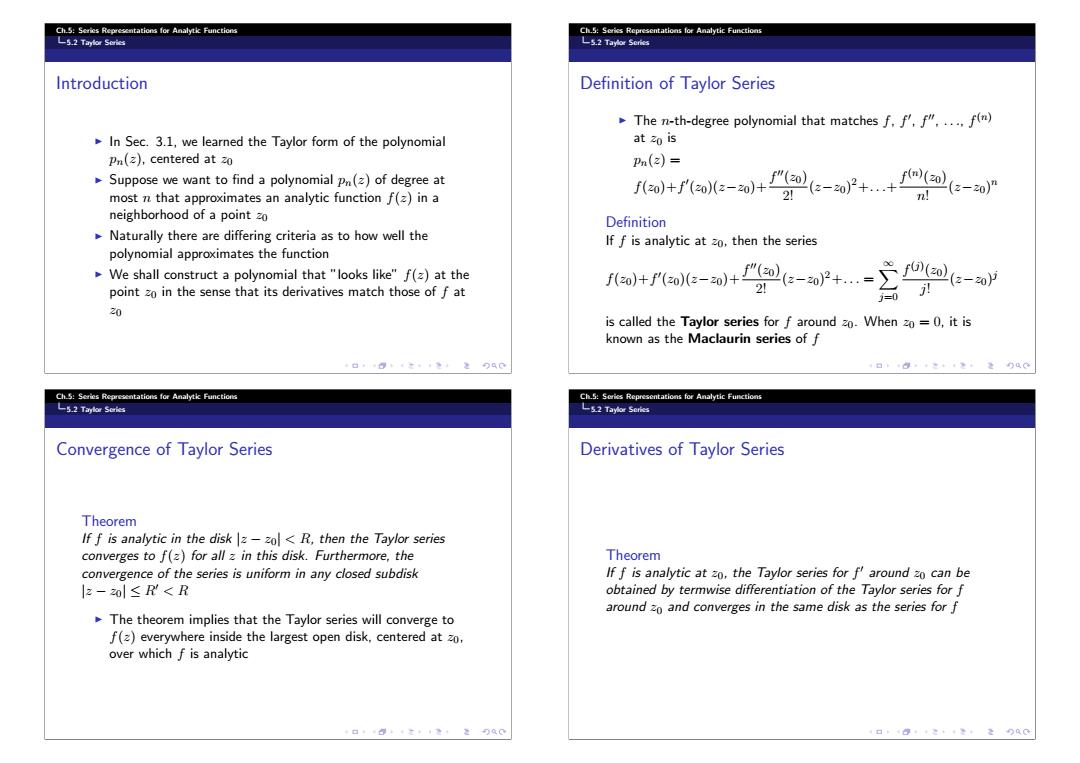
Ch.5:Series Representations for Analytic Functions Ch.5:Series Representations for Analytic Functions L5.2 Tayfor Series L5.2 Taylor Series Introduction Definition of Taylor Series The n-th-degree polynomial that matches f.ff"...f(n) In Sec.3.1,we learned the Taylor form of the polynomial at zo is Pn(z),centered at zo Pn(2)= Suppose we want to find a polynomial pn(z)of degree at most n that approximates an analytic function f(z)in a o+ae-+re-wr++oe-wr neighborhood of a point zo Definition Naturally there are differing criteria as to how well the If f is analytic at zo,then the series polynomial approximates the function We shall construct a polynomial that "looks like"f(z)at the point zo in the sense that its derivatives match those of f at 、0)+fr0(2-20)+20(-0)2+=0(-0 20 is called the Taylor series for f around zo.When zo =0,it is known as the Maclaurin series of f Ch.5:Series Representations for Analytk Functions Ch.5:Scrics Representations for Analytic Functions 5.2 Taylor Sories -5.2 Taylor Series Convergence of Taylor Series Derivatives of Taylor Series Theorem If f is analytic in the disk z-zo<R,then the Taylor series converges to f(z)for all z in this disk.Furthermore,the Theorem convergence of the series is uniform in any closed subdisk If f is analytic at zo.the Taylor series for f'around zo can be |z-20l≤R<R obtained by termwise differentiation of the Taylor series for f around zo and converges in the same disk as the series for f The theorem implies that the Taylor series will converge to f(z)everywhere inside the largest open disk,centered at zo, over which f is analytic
Ch.5: Series Representations for Analytic Functions 5.2 Taylor Series Introduction In Sec. 3.1, we learned the Taylor form of the polynomial pn(z), centered at z0 Suppose we want to find a polynomial pn(z) of degree at most n that approximates an analytic function f(z) in a neighborhood of a point z0 Naturally there are differing criteria as to how well the polynomial approximates the function We shall construct a polynomial that ”looks like” f(z) at the point z0 in the sense that its derivatives match those of f at z0 Ch.5: Series Representations for Analytic Functions 5.2 Taylor Series Definition of Taylor Series The n-th-degree polynomial that matches f, f, f, ..., f(n) at z0 is pn(z) = f(z0)+f(z0)(z−z0)+f(z0) 2! (z−z0)2+...+f(n)(z0) n! (z−z0)n Definition If f is analytic at z0, then the series f(z0)+f(z0)(z−z0)+ f(z0) 2! (z−z0)2+... = ∞ j=0 f(j)(z0) j! (z−z0)j is called the Taylor series for f around z0. When z0 = 0, it is known as the Maclaurin series of f Ch.5: Series Representations for Analytic Functions 5.2 Taylor Series Convergence of Taylor Series Theorem If f is analytic in the disk |z − z0| < R, then the Taylor series converges to f(z) for all z in this disk. Furthermore, the convergence of the series is uniform in any closed subdisk |z − z0| ≤ R < R The theorem implies that the Taylor series will converge to f(z) everywhere inside the largest open disk, centered at z0, over which f is analytic Ch.5: Series Representations for Analytic Functions 5.2 Taylor Series Derivatives of Taylor Series Theorem If f is analytic at z0, the Taylor series for f around z0 can be obtained by termwise differentiation of the Taylor series for f around z0 and converges in the same disk as the series for f������������������
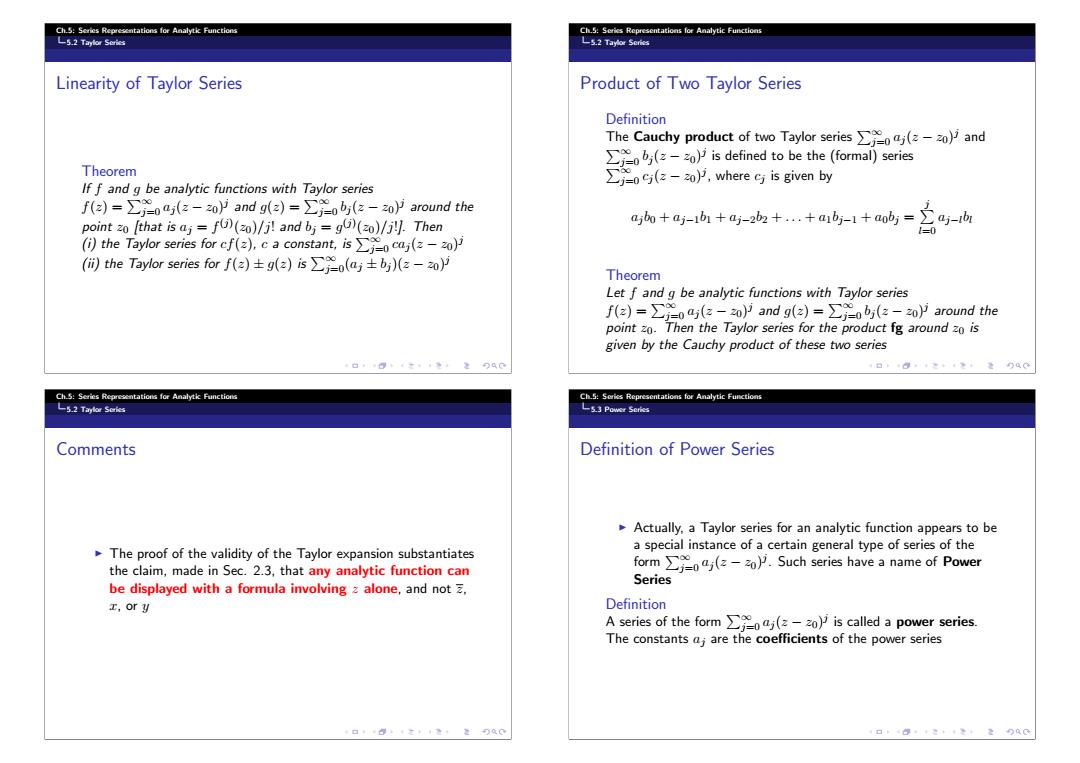
Ch.5:Series Representations for Analytic Functions Ch.5:Series Representations for Analytic Functions L5.2 Tayfor Series L5.2 Taylor Series Linearity of Taylor Series Product of Two Taylor Series Definition The Cauchy product of two Taylor series (-z)and (is defined to be the (formal)series Theorem oSe-2o户,where5 is given by If f and g be analytic functions with Taylor series f(2)=aj(=-z0)and g(=)=(z-zo around the point zo [that is aj=f)(zo)/j!andbj=g)(zo)/j Then a,n+a5-1b1+a-2b++a1b-1+b与=24y-h =0 (i)the Taylor series for cf(=).c a constant,isc() (份the Taylor series forf(a)±g(a)is∑eo(a±b)(a-2oP Theorem Let f and g be analytic functions with Taylor series f(=)=oaj(z-zo)i and g(z)=(2-z0)around the point zo.Then the Taylor series for the product fg around zo is given by the Cauchy product of these two series 4口18。+之+1老+意0G Ch.5:Series Representations for Analyti Functions Ch.5:Scrics Representations for Analytic Functions L5.2 Taylor Sories 5.3 Power Series Comments Definition of Power Series Actually,a Taylor series for an analytic function appears to be The proof of the validity of the Taylor expansion substantiates a special instance of a certain general type of series of the the claim,made in Sec.2.3,that any analytic function can form(.Such series have a name of Power Series be displayed with a formula involving z alone,and not z. 工,ory Definition A series of the form(z)is called a power series. The constants aj are the coefficients of the power series
Ch.5: Series Representations for Analytic Functions 5.2 Taylor Series Linearity of Taylor Series Theorem If f and g be analytic functions with Taylor series f(z) = ∞j=0 aj (z − z0)j and g(z) = ∞j=0 bj (z − z0)j around the point z0 [that is aj = f(j)(z0)/j! and bj = g(j)(z0)/j!]. Then (i) the Taylor series for cf(z), c a constant, is ∞j=0 caj (z − z0)j (ii) the Taylor series for f(z) ± g(z) is ∞j=0(aj ± bj )(z − z0)j Ch.5: Series Representations for Analytic Functions 5.2 Taylor Series Product of Two Taylor Series Definition The Cauchy product of two Taylor series ∞j=0 aj (z − z0)j and ∞j=0 bj (z − z0)j is defined to be the (formal) series ∞j=0 cj (z − z0)j , where cj is given by aj b0 + aj−1b1 + aj−2b2 + ... + a1bj−1 + a0bj = j l=0 aj−lbl Theorem Let f and g be analytic functions with Taylor series f(z) = ∞j=0 aj (z − z0)j and g(z) = ∞j=0 bj (z − z0)j around the point z0. Then the Taylor series for the product fg around z0 is given by the Cauchy product of these two series Ch.5: Series Representations for Analytic Functions 5.2 Taylor Series Comments The proof of the validity of the Taylor expansion substantiates the claim, made in Sec. 2.3, that any analytic function can be displayed with a formula involving z alone, and not z, x, or y Ch.5: Series Representations for Analytic Functions 5.3 Power Series Definition of Power Series Actually, a Taylor series for an analytic function appears to be a special instance of a certain general type of series of the form ∞j=0 aj (z − z0)j . Such series have a name of Power Series Definition A series of the form ∞j=0 aj (z − z0)j is called a power series. The constants aj are the coefficients of the power series��������������
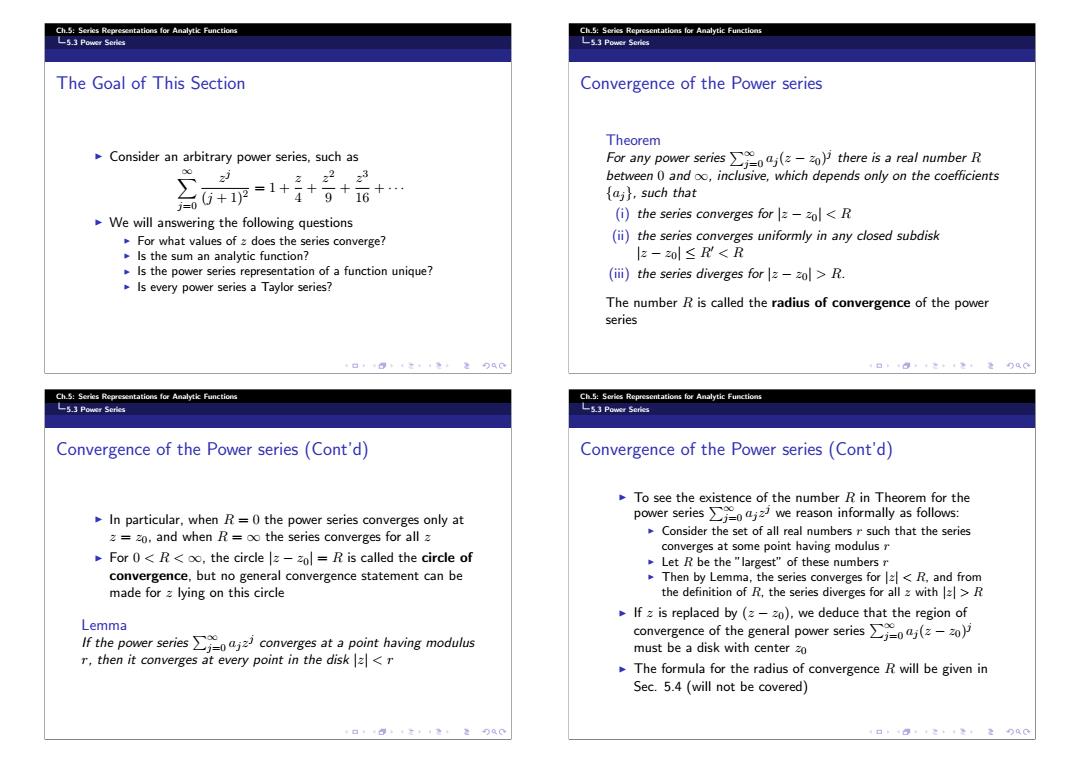
Ch.5:Series Representations for Analytic Functions Ch.5:Series Representations for Analytic Functions L5.3 Power Series L5.3 Power Series The Goal of This Section Convergence of the Power series Theorem Consider an arbitrary power series,such as For any power series)there is real number R 60 ,z2223 G+=1+i++6+… between 0 and oo,inclusive,which depends only on the coefficients aj),such that We will answering the following questions (i)the series converges for z<R For what values of 2 does the series converge? (ii)the series converges uniformly in any closed subdisk Is the sum an analytic function? lz-2ol≤R<R Is the power series representation of a function unique? (iii)the series diverges for z-zol>R. Is every power series a Taylor series? The number R is called the radius of convergence of the power series Ch.5:Series Representations for Analyti Functions Ch.5:Scrics Representations for Analytic Functions 5.3 Power Series 5.3 Power Series Convergence of the Power series(Cont'd) Convergence of the Power series(Cont'd) To see the existence of the number R in Theorem for the In particular,when R=0 the power series converges only at power series we reason informally as follows: z=z0.and when R=oo the series converges for all z Consider the set of all real numbers r such that the series converges at some point having modulus r For 0<R<oo,the circle z-zo=R is called the circle of Let R be the "largest"of these numbers r convergence,but no general convergence statement can be Then by Lemma,the series converges for 2<R,and from made for z lying on this circle the definition of R,the series diverges for all z with >R If z is replaced by (z-zo).we deduce that the region of Lemma If the power series convergesat point having modulus convergence of the general power series) must be a disk with center zo r,then it converges at every point in the disk z<r The formula for the radius of convergence R will be given in Sec.5.4 (will not be covered)
Ch.5: Series Representations for Analytic Functions 5.3 Power Series The Goal of This Section Consider an arbitrary power series, such as ∞ j=0 zj (j + 1)2 =1+ z 4 + z2 9 + z3 16 + ··· We will answering the following questions For what values of z does the series converge? Is the sum an analytic function? Is the power series representation of a function unique? Is every power series a Taylor series? Ch.5: Series Representations for Analytic Functions 5.3 Power Series Convergence of the Power series Theorem For any power series ∞j=0 aj (z − z0)j there is a real number R between 0 and ∞, inclusive, which depends only on the coefficients {aj}, such that (i) the series converges for |z − z0| < R (ii) the series converges uniformly in any closed subdisk |z − z0| ≤ R < R (iii) the series diverges for |z − z0| > R. The number R is called the radius of convergence of the power series Ch.5: Series Representations for Analytic Functions 5.3 Power Series Convergence of the Power series (Cont’d) In particular, when R = 0 the power series converges only at z = z0, and when R = ∞ the series converges for all z For 0 <R< ∞, the circle |z − z0| = R is called the circle of convergence, but no general convergence statement can be made for z lying on this circle Lemma If the power series ∞j=0 ajzj converges at a point having modulus r, then it converges at every point in the disk |z| < r Ch.5: Series Representations for Analytic Functions 5.3 Power Series Convergence of the Power series (Cont’d) To see the existence of the number R in Theorem for the power series ∞j=0 ajzj we reason informally as follows: Consider the set of all real numbers r such that the series converges at some point having modulus r Let R be the ”largest” of these numbers r Then by Lemma, the series converges for |z| < R, and from the definition of R, the series diverges for all z with |z| > R If z is replaced by (z − z0), we deduce that the region of convergence of the general power series ∞j=0 aj (z − z0)j must be a disk with center z0 The formula for the radius of convergence R will be given in Sec. 5.4 (will not be covered)��������������������